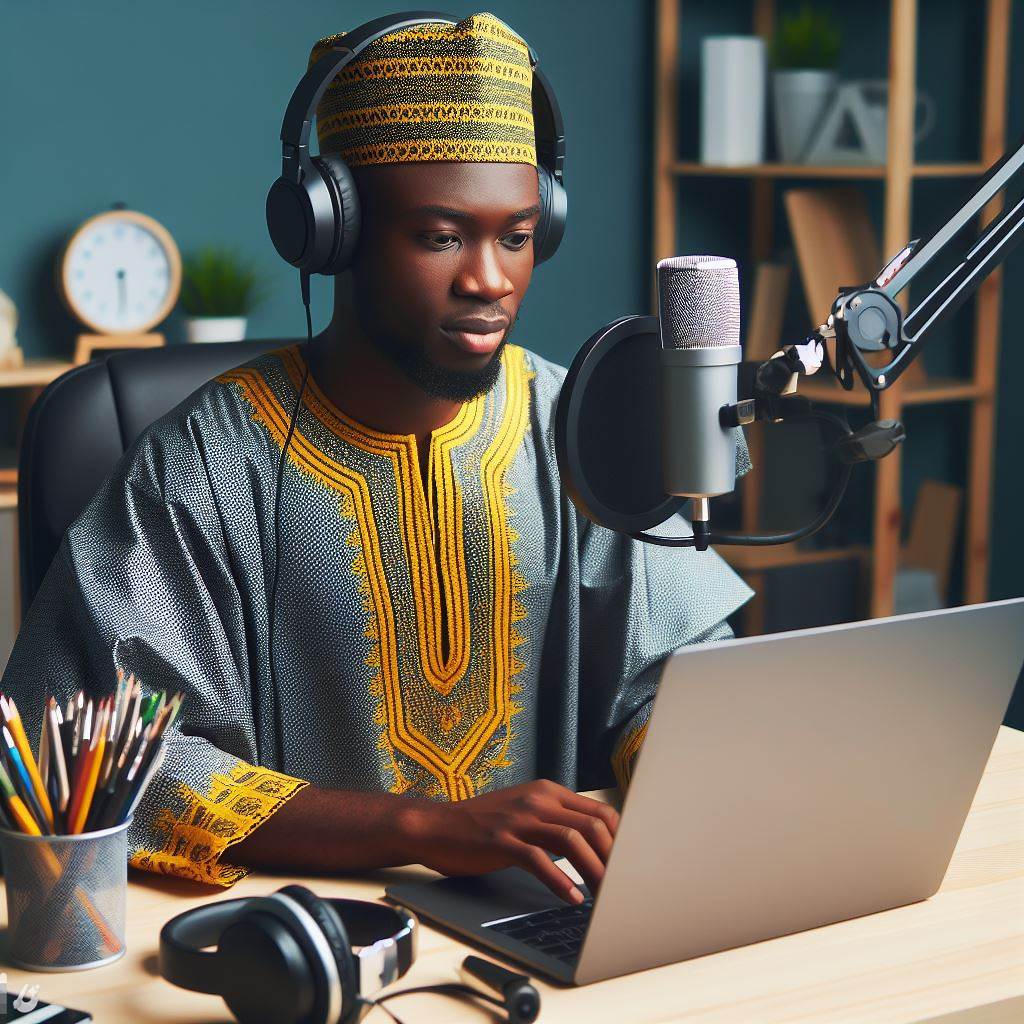Introduction
Podcast equipment plays a crucial role in delivering high-quality audio content to listeners, enhancing their overall experience.
When it comes to podcasting, having the right equipment is essential for producing professional and engaging episodes.
Investing in good-quality microphones, headphones, and audio interfaces can significantly improve the sound quality of a podcast.
A high-quality microphone ensures clear and crisp audio, eliminating unwanted background noises and distractions.
Using headphones allows podcasters to monitor the audio and make necessary adjustments in real-time, creating a better sound mix.
An audio interface acts as the bridge between the microphone and the computer, converting analog signals into digital data.
Choosing the right podcast equipment ultimately leads to an enjoyable and immersive listening experience for the audience.
The better the sound quality, the more engaged and captivated the listeners will be.
Additionally, good equipment can enhance the credibility and professionalism of a podcast, attracting more loyal followers.
Investing in quality podcast equipment is a long-term investment that pays off in terms of audience satisfaction and growth.
Therefore, it is crucial for podcasters to research and select the best equipment that aligns with their specific needs and budget.
In general, podcast equipment plays a vital role in delivering an excellent listener experience.
By investing in good-quality microphones, headphones, and audio interfaces, podcasters can ensure high-quality audio content that captivates and engages their audience.
Essential podcast equipment
When it comes to podcasting, having the right equipment is essential. Here are some of the best picks:
Microphones
- Dynamic Microphones: Ideal for recording in a noisy environment as they minimize background noise.
- Condenser Microphones: Known for their sensitivity and transparent sound quality, perfect for studio recording.
- USB Microphones: These plug-and-play microphones offer convenience and are great for beginners.
Headphones
- Investing in a good pair of headphones is essential for monitoring audio quality during recording and editing.
- Look for headphones that provide accurate and detailed sound reproduction.
Pop filters
- Pop filters are used to reduce plosive sounds caused by strong bursts of air, such as “p” and “b” sounds.
- They help maintain a consistent and clear audio quality by minimizing unwanted noise.
Boom arms
- Boom arms are adjustable microphone stands that allow you to position the microphone precisely.
- They help eliminate desk vibrations and provide better control over microphone placement.
Shock mounts
- Shock mounts are used to isolate the microphone from vibrations and handling noise.
- They help eliminate unwanted sounds and ensure a cleaner audio recording.
Having the right podcast equipment is crucial for producing high-quality content.
Whether you are a beginner or a professional, investing in good microphones, headphones, pop filters, boom arms, and shock mounts can greatly enhance the overall sound of your podcast.
When choosing microphones, consider the environment where you will be recording. If you are in a noisy location, dynamic microphones would be a better choice.
On the other hand, if you have a controlled recording environment, condenser microphones can capture more detail and nuances in your voice.
Personalized Financial Consulting – Tailored for You
Get a custom financial plan made just for you in 1-3 days. Clear strategies, actionable steps, and unlimited revisions.
Get StartedUSB microphones offer convenience, as they can be directly connected to your computer without the need for additional audio interfaces.
This makes them a popular choice for podcasters who are just starting out and don’t want to invest in a complex setup.
Headphones are essential for monitoring the audio quality during recording and editing.
Look for headphones that provide accurate sound reproduction, so you can identify any issues and make necessary adjustments.
Using pop filters can greatly improve the clarity of your recordings by minimizing plosive sounds.
They are easy to attach to microphone stands and act as a barrier between your mouth and the microphone, reducing the impact of harsh consonant sounds.
Boom arms and shock mounts are great accessories that help optimize microphone placement and isolate it from unwanted vibrations. This ensures a cleaner and more professional sound.
Overall, investing in quality podcast equipment will greatly enhance the overall sound of your podcast and provide a better listening experience for your audience.
Best picks for microphones
When it comes to podcasting, having the right equipment is crucial for producing high-quality content. One key element of podcasting equipment is the microphone.
In this section, we will explore some of the best picks for microphones that will help enhance the sound of your podcast.
Shure SM58
The Shure SM58 is a popular choice among podcasters for its durability and excellent sound quality. Its cardioid polar pattern helps isolate the sound source and minimize background noise.
Audio-Technica ATR2100x-USB
This microphone offers both USB and XLR outputs, making it versatile and compatible with various recording setups. It has a built-in headphone jack for real-time monitoring.
Rode PodMic
Designed specifically for podcasting, the Rode PodMic delivers clear and professional-sounding audio. It has a dynamic capsule and a built-in pop filter to minimize plosives.
Blue Yeti USB Microphone
The Blue Yeti, favored by beginners for its plug-and-play ease, offers versatile pickup patterns like cardioid and bidirectional.
For any microphone choice, consider the type; dynamic ones excel in podcasting for lower sensitivity to background noise.
Polar pattern matters too, with cardioid microphones, popular for podcasting, focusing on front sound capture while minimizing side and rear noise.
Connectivity options vary, with USB microphones being user-friendly, but XLR microphones provide superior audio quality, often preferred by professionals.
Additional features like headphone jacks, built-in pop filters, and adjustable stands enhance the podcasting experience.
Essential equipment includes quality headphones for audio monitoring and a soundproof environment—achieved with acoustic panels or foam to reduce echoes and background noise.
A quiet room or closet with clothes can serve as a makeshift recording booth.
To ease editing, invest in a pop filter, shock mount, and boom arm for enhanced sound quality.
Noteworthy microphones for podcasters include Shure SM58, Audio-Technica ATR2100x-USB, Rode PodMic, and Blue Yeti USB Microphone.
Choose a podcasting microphone based on type, polar pattern, connectivity, and features to ensure a top-notch podcasting experience in a soundproof environment with essential equipment.
Read: SEO for Bloggers: Increase Traffic
Unlock Your Path to Financial Freedom
Personalized savings and investment strategies tailored to your financial goals. Let's help you take control of your future with a plan designed just for you.
Get StartedChoosing the right headphones
When it comes to podcasting, having the right equipment is crucial for creating high-quality content. One essential piece of equipment that every podcaster needs is a good pair of headphones.
But with so many options available, how do you choose the right headphones for your podcasting needs? Here are a few things to consider:
Closed-back vs. open-back headphones
- Closed-Back Headphones: Closed-back headphones are ideal for recording in noisy environments. They provide excellent noise isolation, allowing you to focus on your audio without any distractions.
- Open-Back Headphones: Open-back headphones, on the other hand, have perforated ear cups that allow some sound to leak in and out. They offer a more natural sound and a wider soundstage, making them great for mixing and mastering.
Comfort and fit
- Podcasting can require long hours of wearing headphones, so comfort is essential. Look for headphones with adjustable headbands and cushioned ear cups to prevent discomfort during extended use.
- It’s also important to consider the weight of the headphones. Heavy headphones can put unnecessary strain on your neck and head, leading to discomfort and fatigue.
Audio quality
- The most crucial aspect of any headphones is the audio quality they deliver. Look for headphones that provide a neutral and balanced sound signature, allowing you to accurately hear and analyze your audio.
- Pay attention to frequency response. Look for headphones that cover the entire range of human hearing, from 20Hz to 20kHz, to ensure that you don’t miss any details in your audio.
Some recommended options
Audio-Technica ATH-M50x
These headphones are highly popular among podcasters for their excellent sound quality and durability. They have a closed-back design for optimal noise isolation.
Sennheiser HD 280 Pro
These headphones offer a comfortable fit and deliver accurate sound reproduction. They also come with a folding design, making them easy to travel with.
Beyerdynamic DT 770 Pro
With their closed-back design and impressive bass response, these headphones are great for podcasters who want to monitor their audio with precision.
All-in-all, choosing the right headphones is essential for podcasters looking to produce high-quality content.
By considering factors such as closed-back vs. open-back, comfort and fit, and audio quality, you can find the perfect pair of headphones for your podcasting needs.
Don’t underestimate the impact that good headphones can have on the overall quality of your podcast.
Read: Podcasting Profit: Start to Earn

Delve into the Subject: Successful Blog Layouts: Examples
Importance of pop filters and boom arms
In podcasting, having the right equipment is crucial to ensure high-quality audio for your listeners. Two essential tools that you should consider investing in are pop filters and boom arms.
These devices play a significant role in improving audio clarity and overall production value. Let’s delve deeper into the importance of pop filters and boom arms in podcasting.
Reducing plosive sounds for better audio quality
Pop filters are designed to reduce plosive sounds, which are caused by the strong air bursts produced when pronouncing certain sounds like “p” and “b.”
These sounds can create unpleasant audio distortions and affect the overall listening experience.
By placing a pop filter in front of your microphone, you can effectively minimize these plosive sounds, resulting in clearer and more professional audio quality.
Top picks for pop filters and boom arms
When it comes to pop filters, one top pick is the Aokeo Professional Microphone Pop Filter.
This filter features a double layer of mesh that effectively captures plosive sounds while allowing your voice to pass through with minimal impedance.
Its sturdy and flexible gooseneck arm allows you to position the filter at the optimal distance from your microphone, ensuring maximum effectiveness.
Aokeo Professional Microphone Pop Filter
Another essential piece of equipment for podcasting is a boom arm. A boom arm is a flexible and extendable arm that holds your microphone in place.
It allows you to position the microphone at the perfect height and angle, providing you with the ideal recording setup.
Heil Sound PL-2T Overhead Broadcast Boom
The Heil Sound PL-2T Overhead Broadcast Boom is a popular choice among podcasters.
This boom arm offers exceptional stability and adjustability, allowing you to position your microphone exactly where you need it.
With its built-in cable management system, you can keep your setup neat and organized, avoiding any cable clutter that could affect audio quality.
Using a boom arm has several advantages. First and foremost, it helps eliminate surface vibrations and handling noise, resulting in a cleaner and more professional sound.
It also allows you to maintain a consistent distance between your mouth and the microphone, ensuring consistent audio levels throughout your recording.
Additionally, a boom arm reduces the likelihood of accidental bumps or knocks that could disrupt your recording.
By using pop filters and boom arms in your podcasting setup, you can significantly enhance the audio quality of your recordings.
Crisp and clear audio makes it easier for your listeners to engage with your content and enhances the overall professionalism of your podcast.
Take Control of Your Debt Today
Struggling with debt? Get personalized strategies to pay off your debts, negotiate with creditors, and rebuild your credit. Your path to financial freedom starts here.
Get HelpTo recap, pop filters are crucial for reducing plosive sounds, while boom arms provide stability and flexibility for optimal microphone positioning.
The Aokeo Professional Microphone Pop Filter and the Heil Sound PL-2T Overhead Broadcast Boom are excellent choices for these respective tools.
Investing in these essential podcasting accessories will undoubtedly elevate the quality of your recordings and improve the listening experience for your audience.
Read: YouTube Earnings: Boost Your Channel
The significance of shock mounts
In podcasting, having the right equipment is crucial to ensuring the best audio quality.
Minimizing vibrations and handling noise
One key piece of equipment that often gets overlooked is the shock mount. Shock mounts are designed to minimize vibrations and handling noise, resulting in cleaner and more professional-sounding recordings.
Top choices for shock mounts
There are several top choices for shock mounts that podcasters swear by:
- Rode PSM1 Shock Mount: The Rode PSM1 shock mount is a popular choice among podcasters due to its sturdy construction and excellent noise isolation capabilities.
- Heil Sound PRSM-B Shock Mount: The Heil Sound PRSM-B shock mount is another favorite among podcasters. It provides exceptional shock absorption and is compatible with a wide range of microphones.
Selecting the right shock mount for your microphone is essential, as not all are universal. Verify compatibility before purchase to avoid issues.
The importance of shock mounts cannot be overstated; vibrations and handling noise can compromise recording quality.
Even if your microphone has built-in shock absorption, investing in a dedicated shock mount is advisable for optimal results.
Beyond noise reduction, shock mounts safeguard your microphone from physical damage by isolating it from vibrations and sudden movements.
This prolongs the microphone’s lifespan and prevents potential mishandling damage.
Consider the weight and size of your microphone when choosing a shock mount, ensuring a secure fit without being too loose or tight.
Opt for easy installation with features like clamps or swivel mounts for a quick setup.
Check customer reviews and ratings for insights into shock mount quality, durability, and performance. Shock mounts, like the Rode PSM1 and Heil Sound PRSM-B, are highly recommended by podcasters.
In essence, shock mounts are crucial for top-notch podcast recordings, minimizing vibrations and handling noise for cleaner, professional audio.
Enhance your podcast’s audio quality and provide a superior listening experience by choosing a compatible, easily installed shock mount with positive reviews.
Read: Maximize Blog Income: Top Strategies
Conclusion
In closing, podcast equipment plays a crucial role in creating a successful podcast.
By investing in high-quality equipment, podcasters can deliver a professional and enjoyable podcasting experience to their audience.
Good equipment ensures clear audio, eliminates background noise, and enhances the overall quality of the podcast. It also allows for greater flexibility and creativity in terms of recording and editing.
Therefore, it is essential for podcasters to carefully choose the right equipment to meet their specific needs.
Whether it’s a good microphone, headphones, audio interface, or recording software, each piece of equipment contributes to the overall podcasting experience.
By choosing the right equipment, podcasters can enhance their production value, attract a larger audience, and stand out in the competitive podcasting industry.
So, if you are serious about podcasting, it is worth investing in top-quality podcast equipment. Don’t compromise on the quality of your podcast by using subpar equipment.
Investing in the right tools will not only improve the sound quality but also save you time and frustration in the long run.
Ultimately, podcasting is all about connecting with your audience, and high-quality equipment helps you make that connection effectively.
So, go ahead and invest in the right podcast equipment, and take your podcasting experience to the next level!




